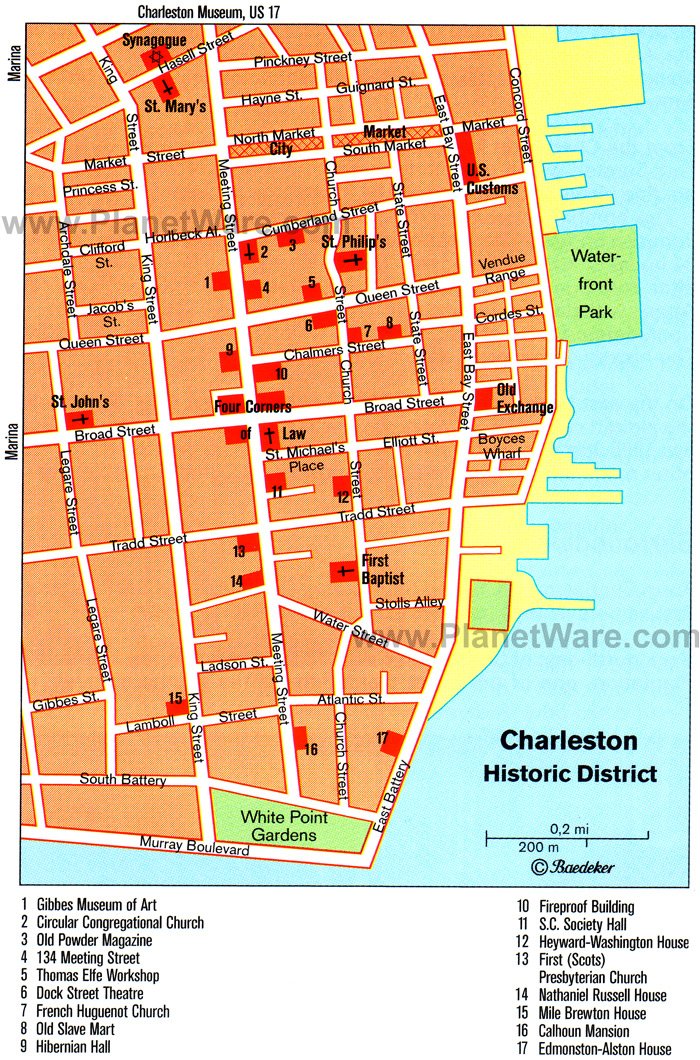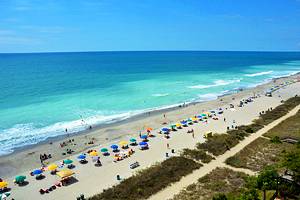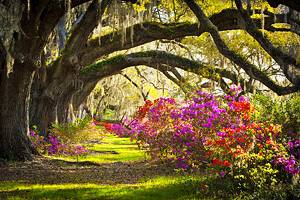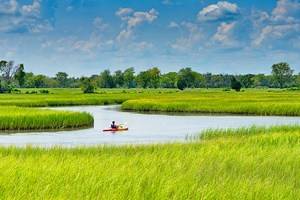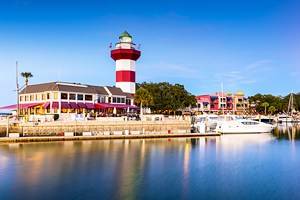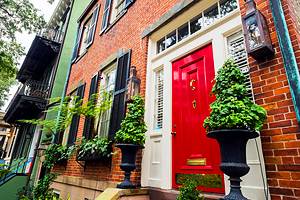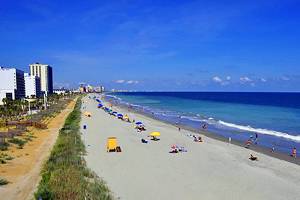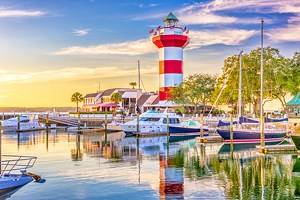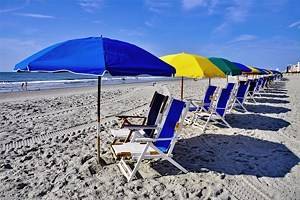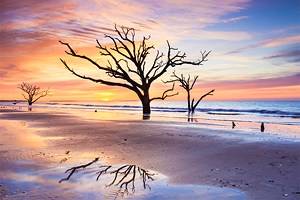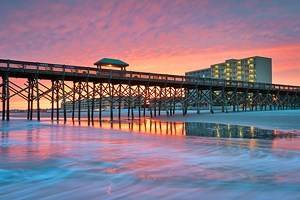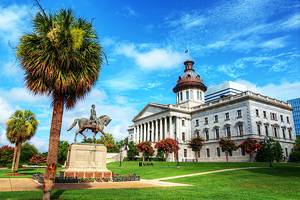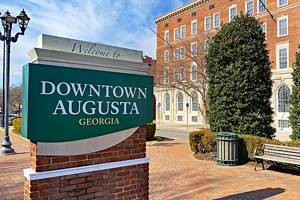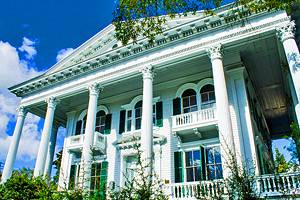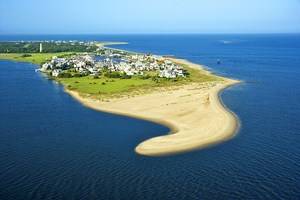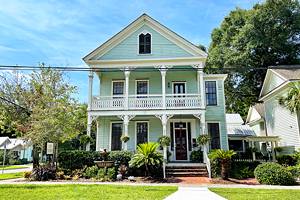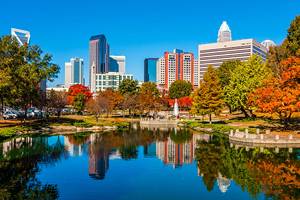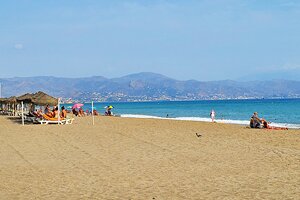19 Top-Rated Tourist Attractions in Charleston, SC
There is something about Charleston's charm that never gets old and keeps travelers returning year after year. With its walkable downtown, a legacy dating back to the 1700s, and easy-on-the-eyes architecture, this Southern port city is like no other place in America.
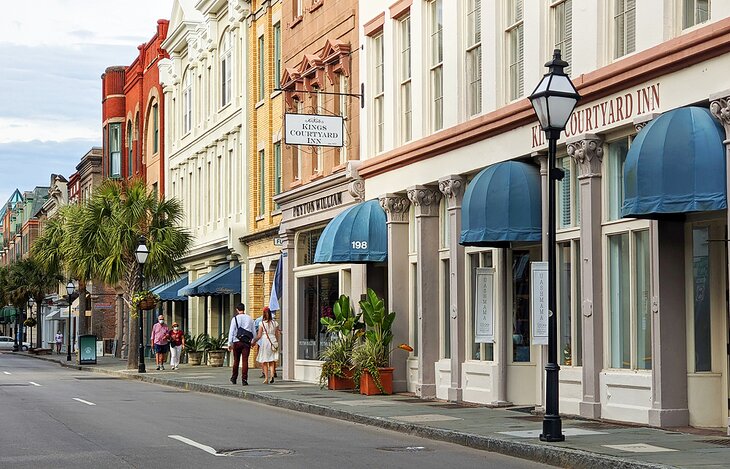
The Holy City is the kind of place where old and new intersect. You can spend a morning learning about the city's complicated history on a horse-drawn carriage ride and an evening staying very much in the present with a meal at one of its buzzy, innovative restaurants showcasing the best of Lowcountry cuisine. You'll find endless things to do here.
Make sure to pack some good walking shoes to see the attractions, because you'll want to explore as much of Charleston as possible on foot. Take a walk down centuries-old cobblestone streets in the historic district with its church towers and veranda-fronted homes. Stop to peek into Spanish moss-covered gardens in the alleys behind the graceful old mansions lining its waterfront around The Battery.
Or head to one of the many barrier islands just offshore to walk in the sand and play in the sea.
The city is also home to the oldest landscaped gardens in the U.S. and a few excellent museums. Check out our guide to learn more about Charleston's top attractions.
- Middleton Place
- Waterfront Park
- International African American Museum
- Magnolia Plantation & Gardens
- Watch Basket Weavers at the Old City Market
- Take a Boat to Fort Sumter National Monument
- USS Yorktown and Patriots Point
- Stroll through the Battery and White Point Gardens
- See Angel Oak and Johns Island
- South Carolina Aquarium
- Bike across the Ravenel Bridge
- Boone Hall Plantation
- The Charleston Museum
- Drayton Hall
- Old Slave Mart Museum
- Nathaniel Russell House and Aiken-Rhett House
- Cathedral of St. John the Baptist and Historic Churches
- Calhoun Mansion
- Tour Historic Homes at the Festival of Houses and Gardens
- Map of Attractions & Things to Do in Charleston, SC
- Charleston - Climate Chart
Middleton Place
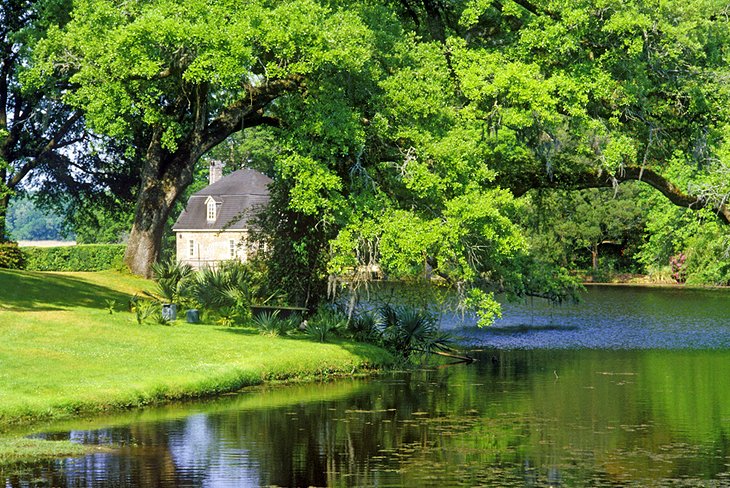
Home to America's oldest landscaped gardens, Middleton Place is a National Historic Landmark that began in 1675 as a rice plantation. Once the home of the Middleton family, whose lineage included two of the country's Founding Fathers, today it is a living history museum.
It tells its complicated, often dark story, which included the generations of enslaved labor, in a truthful manner. The Beyond the Fields: Enslavement at Middleton Place documentary is shown three times daily and recognizes the stories of "brutality, survival, contribution, and perseverance" of the people enslaved here.
Visitors can also tour the 1755 Middleton family home, where you'll see large garden rooms, rare books, porcelain, and family portraits. As well as paying a visit to the Stableyards, where you'll meet the heritage breed livestock.
The gardens are the real treat, however. Covering some 65 acres, they feature a magnificent series of descending terraces, hedged galleries, and pools, the grounds show off their symmetrical 17th-century European design. The gardens bloom year-round with rare camellias in the winter and azaleas in the spring. Walking tours of the gardens are included with admission and offered daily at the top of the hour between 10am and 3pm.
Look for Middleton Place on the Ashley River, about 15 miles north of downtown Charleston.
Official site: https://www.middletonplace.org
Waterfront Park
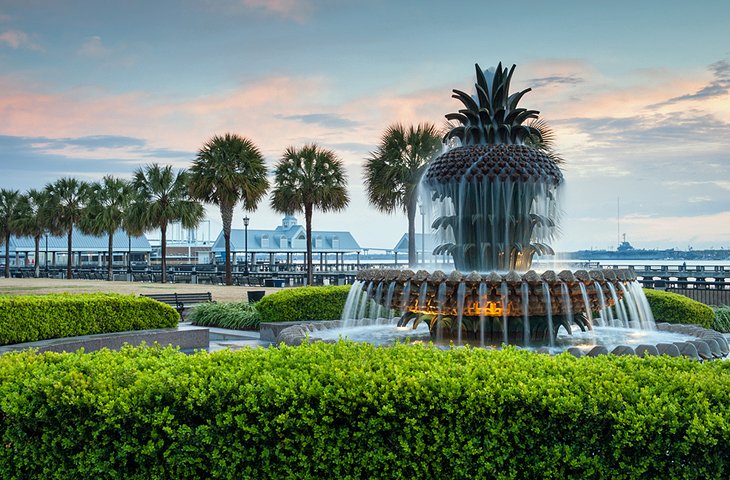
A place where tourists and locals gather to relax and enjoy the views of Charleston Harbor, the 12-acre Waterfront Park stretches along more than 1,000 feet of waterfront. Old-fashioned park benches and double swings face the water, where sailboats and larger ships are common sights.
Fountains, including the unusual Pineapple Fountain, are lighted at night, and seasonal flower gardens add splashes of color. The park's central location near the City Market and historic sights, along with its free Wi-Fi, make it even more popular.
Address: 1 Vendue, Charleston, South Carolina
International African American Museum
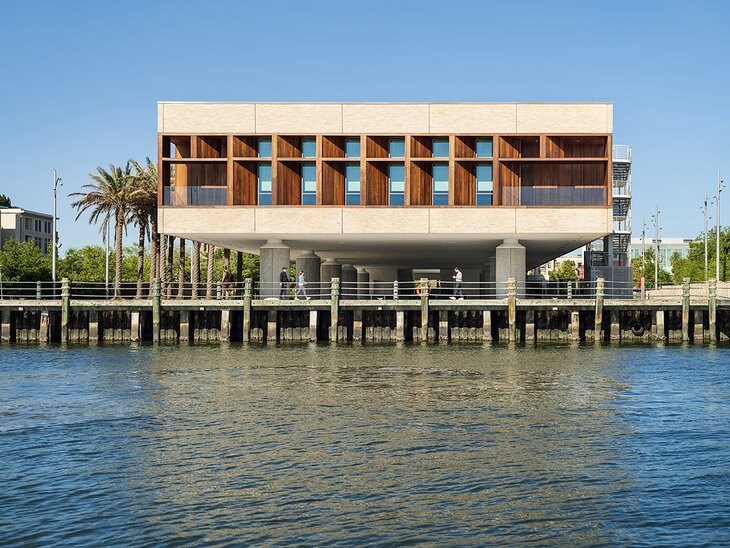
After 20-years of planning and $100 million in costs, the International African American Museum (IAAM) opened in Gadsen's Wharf and brings Charleston's role in the slave trade to the forefront.
The museum's location is significant because Gadsen's Wharf was the U.S. entry point for more than 40 percent of captive Africans sold into slavery at auctions here beginning in 1783. In fact, it is believed that more than 80 percent of African Americans, including Michelle Obama, can trace one or more ancestors back to Charleston.
The museum's mission is to document the journey captive Africans were forced to take from the 1700s onward. The exhibitions in the nine galleries tell the unvarnished story of the brutality these enslaved people, and their descendants, endured from a local, national, and international perspective. It also has a Center for Family History that will serve as a first-of-its-kind resource for the study and advancement of African American genealogy.
The International African American Museum's site choice and building financial investment is one of several ways Charleston is owning up to the role it played in enslaving humans after years of downplaying it. The first came in 2015 when the Confederate flag was finally removed from the South Carolina State House. The city council also formally apologized for Charleston's role in slavery in 2018.
Official site: https://iaamuseum.org/
Magnolia Plantation & Gardens
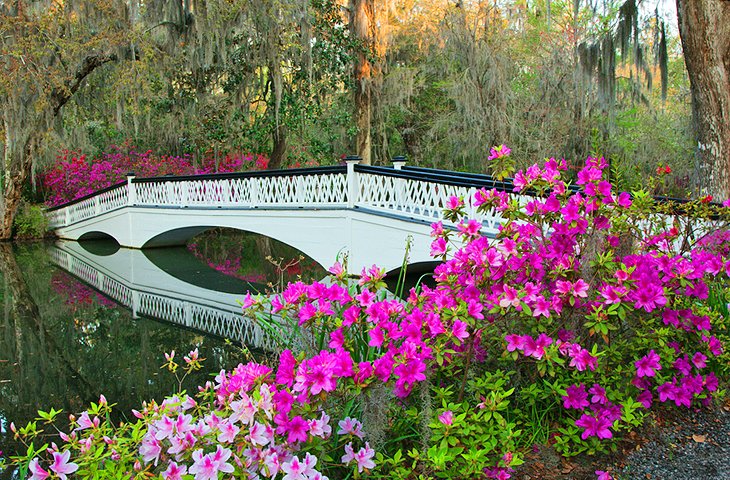
It's not just garden lovers who will be enchanted by the year-round beauty of Magnolia Plantation's extensive gardens. These are America's oldest publicly accessed gardens, first opened to visitors in 1870, although portions of them date to two centuries earlier. They are also the nation's last large-scale Romantic-style garden, in contrast to most show gardens where nature is controlled and shaped by formal beds, paths, and landscaping.
Nurtured by generation after generation of the same family, the gardens have grown as each subsequent owner added new features. You can take a guided tour of the house, visit an Antebellum cabin, take a boat tour, see exhibits, and take younger visitors to a nature center and petting zoo.
Address: 3550 Ashley River Road, Charleston, South Carolina
Official site: www.magnoliaplantation.com
Watch Basket Weavers at the Old City Market
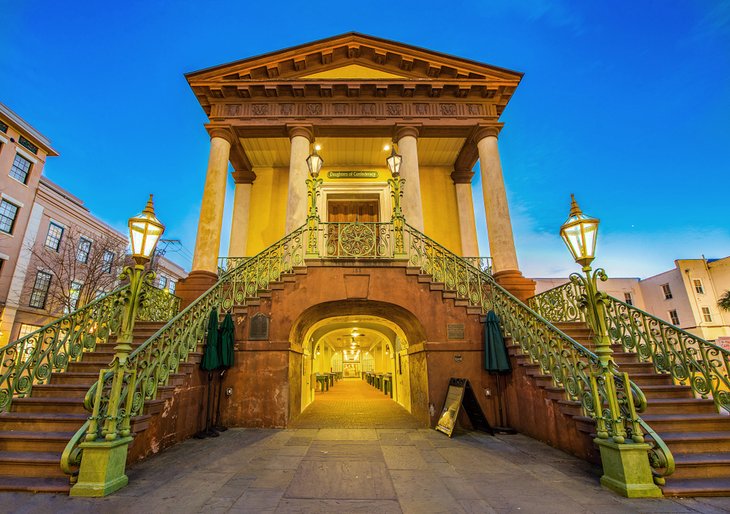
One of the most popular things to do in Charleston is to browse through the old market building, a prominent landmark in the historic district. Lively and colorful, it is a good place for souvenir shopping and just absorbing the local atmosphere.
Vendors sell locally made handcrafts and traditional food products like stone-ground grits, but the prime souvenirs of Charleston are the beautiful sweetgrass baskets. As tourists watch fascinated, Gullah artisans in the open-air "sheds" alongside the market hall weave these intricate works of art from native Lowcountry rushes, creating treasures that are among the country's oldest and most highly prized traditional crafts. The techniques and patterns originated in West Africa, and these baskets are the quintessential souvenir of Charleston.
Built in 1841 in the Greek Revival style, the red sandstone building with green ironwork trim, along with its sheds, are among the more than 100 sites in the city listed on the National Register of Historic Places.
Location: Between North and South Market streets
Official site: https://www.thecharlestoncitymarket.com
Take a Boat to Fort Sumter National Monument
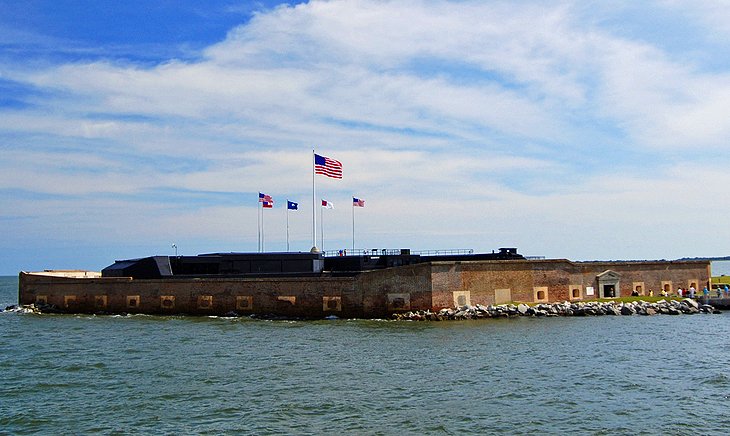
The American Civil War began on April 12, 1861, at Fort Sumter, when the Confederacy pummeled the federal fort in Charleston Harbor. At the end of the war, the American flag was once again raised over the remains of Fort Sumpter, exactly four years after the attack.
The ruins of the battered fort are well preserved, and National Park Rangers tell the story of Fort Sumter and how it helped shape history.
Visitors must ride to the island by boat, from the Visitor Education Center downtown at Liberty Square or from Patriots Point, a good chance to view the city from the water.
Official site: www.nps.gov/fosu/index.htm
USS Yorktown and Patriots Point
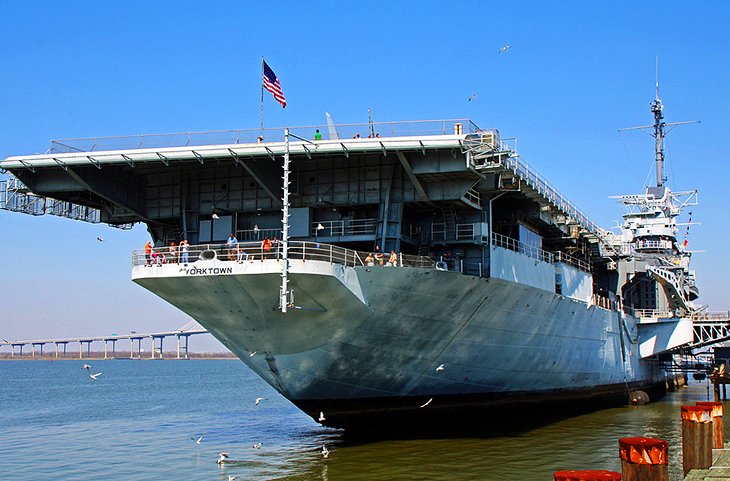
Just across Charleston Harbor from the Historic District is Patriots Point, where you can board the USS Yorktown. This immense vessel was the tenth aircraft carrier to serve in the United States Navy, receiving the Presidential Unit Citation and earning 11 battle stars for service in World War II, as well as five battle stars for service in Vietnam.
The USS Yorktown was also the vessel selected to recover the Apollo 8 astronauts, and even made a film debut in the 1944 documentary The Fighting Lady. The USS Yorktown was retired to Patriots Point Naval and Maritime Museum in 1975. While at Patriots Point, you can also tour aircraft, submarines, and other maritime exhibits.
Address: 40 Patriots Point Road, Mount Pleasant, South Carolina
Official site: www.patriotspoint.org
Stroll through the Battery and White Point Gardens
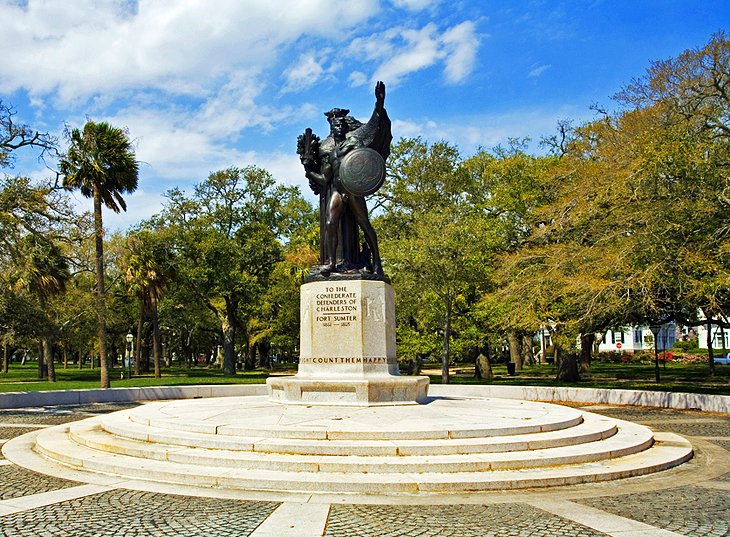
The promenade along the seawall washed by the Ashley and Cooper Rivers, as they meet and form Charleston Harbor, became a public garden in 1837 but was fortified as Battery Ramsey when the Civil War began.
Historic mortars and cannons from that war, as well as a Confederate monument, are displayed here, but the main reason the park is a favorite place for tourists to stroll is that it is bordered by some of Charleston's grandest stately homes and mansions, and offers a spectacular view of Fort Sumter and Charleston Harbor.
Address: Murray Blvd, Charleston, South Carolina
See Angel Oak and Johns Island
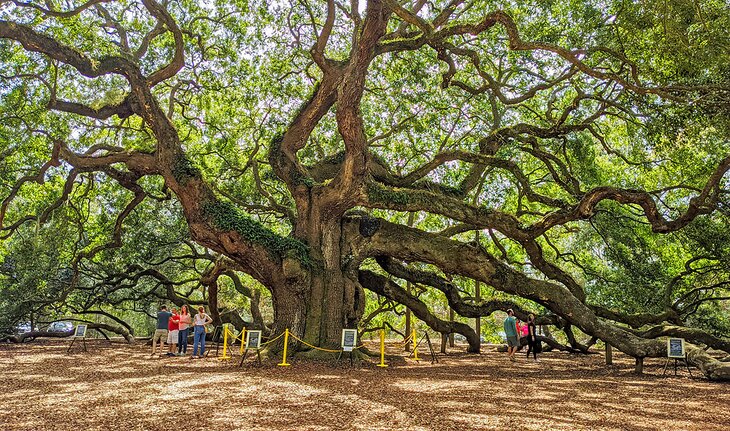
Paying a visit to Angel Oak on Johns Island is well worth the pretty 20-minute drive from downtown. This magical tree is thought to be one of the oldest living oak trees east of the Mississippi. It is 65 feet tall, 25.5 feet wide, and provides shade to more than 17,2000 square feet.
The tree is thought to be between 300 and 400 years old. It is preserved by the city as a historical site and sees about 400,000 visitors each year.
There is more than just Angel Oak to see on Johns Island. The largest island in South Carolina, it has an undeveloped, still wild vibe throughout. The island is home to numerous live oak trees and draped in Spanish moss that will have you stopping to take pictures at every turn.
If the season is right, rent a kayak, SUP, or charter a small fishing boat to explore the salt marshes and rivers here. It's a wonderfully relaxing way to spend a morning or afternoon and birdwatchers will rejoice at the number of species that can be spotted.
Johns Island is also a jumping-off point on the way to two of the region's most popular barrier island beaches on Kiawah and Folly Islands.
Folly Beach can get very crowded on hot summer days, and parking can be difficult, but the beach is one of the best around. Drive away from the central part of the beach on E. Arctic Ave., however, and you'll find fewer people and better parking.
Kiawah Island also has beautiful beaches and excellent golf.
South Carolina Aquarium
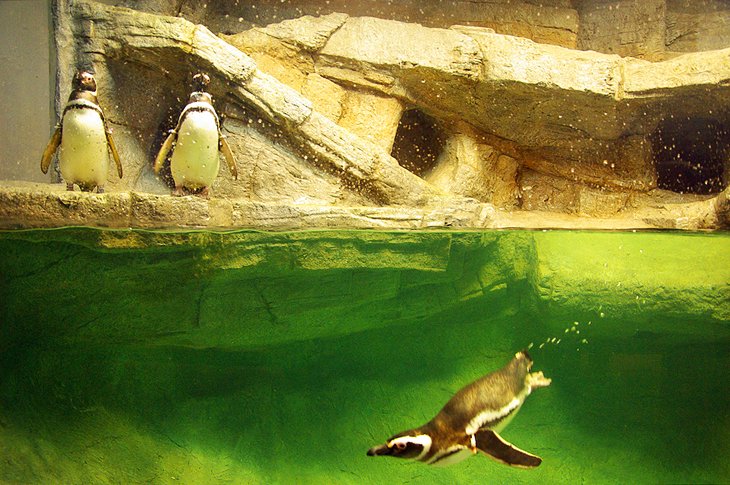
One of the most popular things to do for families in Charleston is the South Carolina Aquarium. Despite its name, it isn't just home to underwater creatures. Birds, land-dwelling mammals, plants, and reptiles join the sea inhabitants in every kid's favorite Charleston attraction.
The emphasis is on participation, so in addition to the two-story, 385,000-gallon aquarium tank, where there are daily interactive shows, you'll find Shark Shallows, where you can touch sharks and rays, and a touch tank with starfish and other creatures.
To get a feel for the behind-the-scenes animal care, visitors can tour the aquarium's Sea Turtle Hospital - South Carolina's only hospital for sick and injured sea turtles. The aquarium's best-loved resident is Caretta, a 220-pound loggerhead sea turtle that lives in the Great Ocean Tank.
Official site: http://scaquarium.org
Bike across the Ravenel Bridge
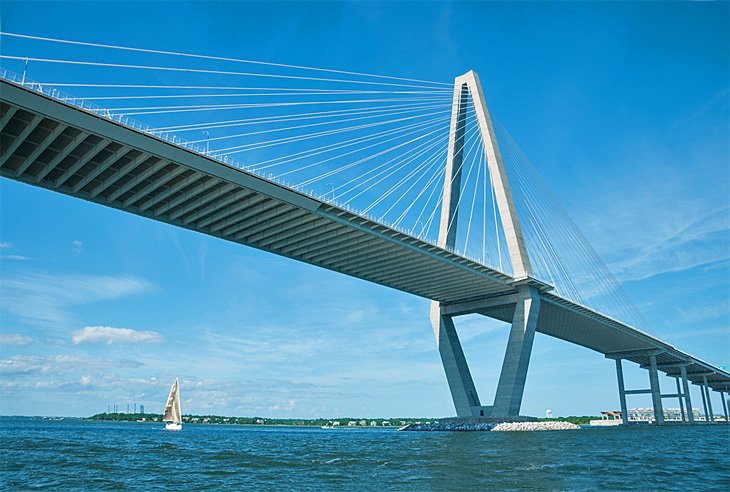
The Arthur Ravenel Jr. Bridge across the Cooper River, joining downtown Charleston to Mount Pleasant, became a well-loved landmark immediately upon its completion in 2005. Its sleek cable-stay design is more than just a pretty bridge: it is built to withstand winds in excess of 300 miles per hour and a 7.4-scale earthquake, and even to prevent collisions with ships.
Along with its multiple traffic lanes, the bridge includes a shared bicycle-pedestrian path named Wonders' Way, and walking or biking across it is a favorite activity for its sweeping views of Charleston.
Boone Hall Plantation
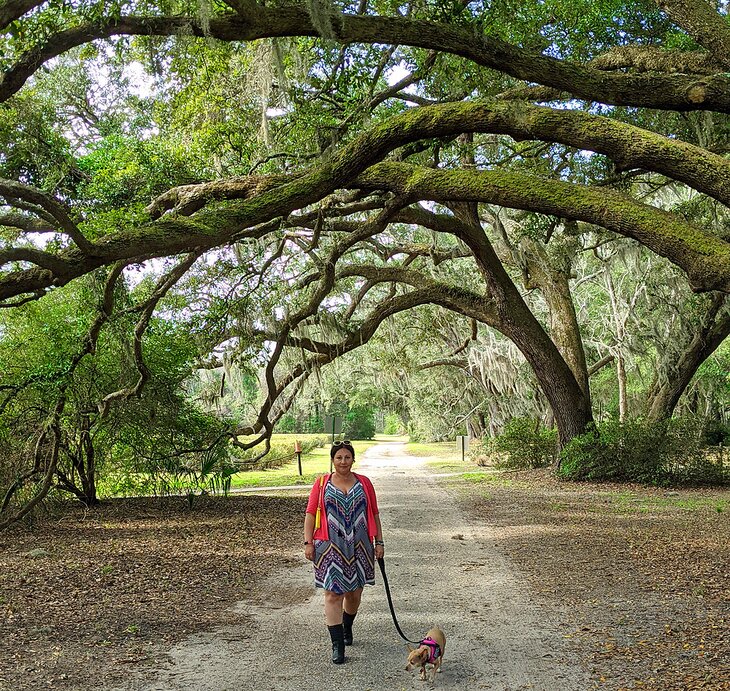
One of America's oldest working plantations, the 1681 Boone Hall is best known for its moss-draped, three-quarter-mile Avenue of Oaks and for preserving original cabins of enslaved people. The highly photogenic trees that frame the approach to Boone Hall were planted in 1743 by the son of Major John Boone, the original owner.
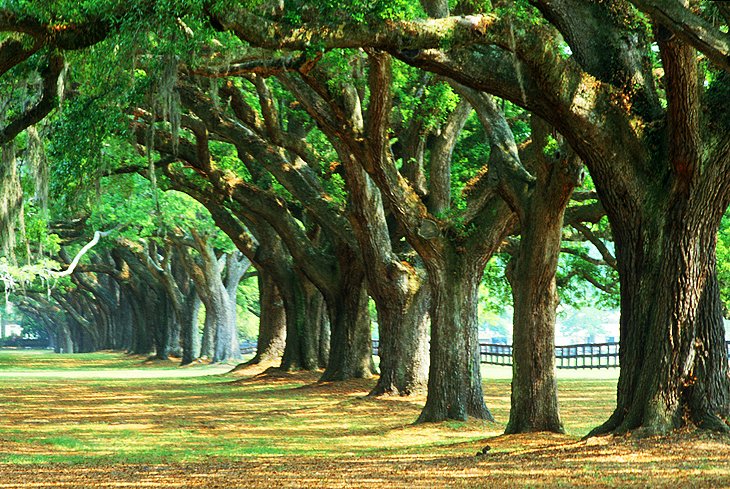
Crops have been continuously grown here for more than three centuries, and you can buy fruits, berries, and vegetables at their Boone Hall Farms Market, close to the plantation on Hwy. 17.
Address: 1235 Long Point Road, Mount Pleasant, South Carolina
Official site: www.boonehallplantation.com/
The Charleston Museum
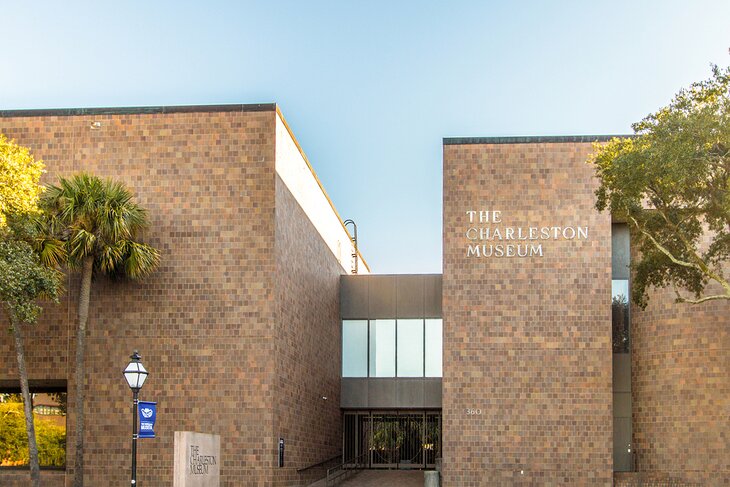
Known as "America's First Museum," The Charleston Museum was founded in 1773 under the Charleston Library Society. Its collections are vast, arranged in a number of permanent exhibits that begin with Native Americans and early settlers in the Lowcountry History Hall, where you can see rare slave badges and early tools used in rice growing.
Exhibit areas illustrate early weaponry, life during the Revolution, and Charleston's role in the Civil War. The Early Days gallery displays the often-quirky collections of 19th-century world travelers, including an Egyptian mummy and case and Greek and Roman antiquities.
The Loeblein Gallery of Charleston Silver shows southern-made silver through the Victorian era (including George Washington's christening cup), and the Historic Textiles Gallery shows changing examples from the museum's outstanding collection of historic needlework, costumes, and textiles. Kidstory brings the history of Charleston and the Lowcountry to life in hands-on exhibits.
Address: 360 Meeting Street, Charleston, South Carolina
Official site: www.charlestonmuseum.org
Drayton Hall
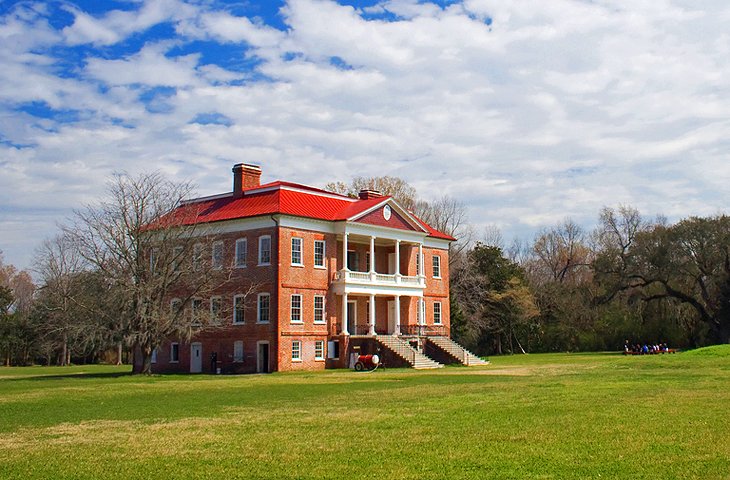
The elegant Drayton Hall is the oldest unrestored plantation house in America still open to the public. Similar to other local plantations, Drayton Hall offers guided house tours, but where it differs is that the house itself (its walls, floors, and fireplaces) remains virtually undisturbed, giving a rare glimpse into the past.
Dating from 1738, Drayton Hall Plantation was one of the few to survive the Civil War intact. Its interiors still feature ornamental details and original 18th-century craftsmanship. Other personal touches also remain, including as a children's growth chart dating back more than 300 years.
Drayton Hall also acknowledges the role it played in the larger history of the American South, including its abuse of enslaved people. The plantation's African-American cemetery, dating from about 1790, is among the oldest African-American cemeteries in the nation still in use.
Many travelers chose to combine a visit to Drayton Hall and Middleton Place. And you can purchase a joint entry ticket on Drayton Hall's website.
Official site: http://www.draytonhall.org
Old Slave Mart Museum
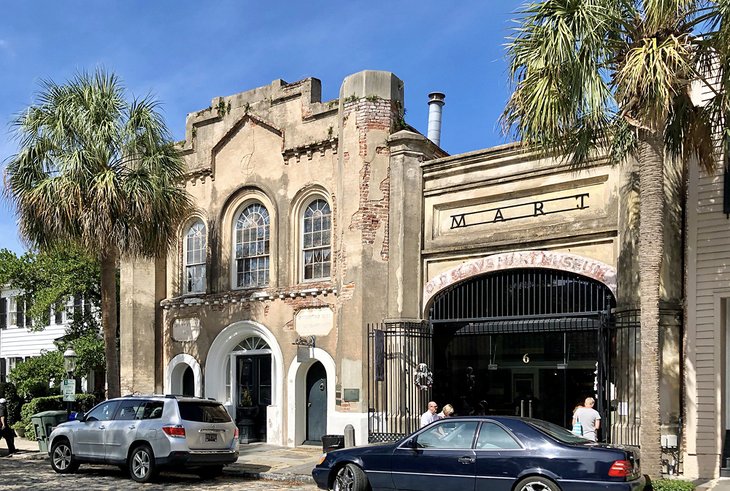
In the heart of the French Quarter, near the French Huguenot Church, the Old Slave Mart Museum is set inside the building where enslaved people were auctioned prior to the Civil War and is a somber, but important part of a Charleston trip focusing on history.
The tour is self-guided, with signage explaining the history. There are also personal accounts from enslaved individuals, artifacts, and audio and visual exhibits. It is a small but deeply affecting museum that gives a sobering view of history.
A block away is the Old Exchange & Provost Dungeon, where costumed guides relate a history of pirates and patriots who were once imprisoned here.
Address: 6 Chalmers Street, Charleston, South Carolina
Official site: http://www.oldslavemartmuseum.com
Nathaniel Russell House and Aiken-Rhett House
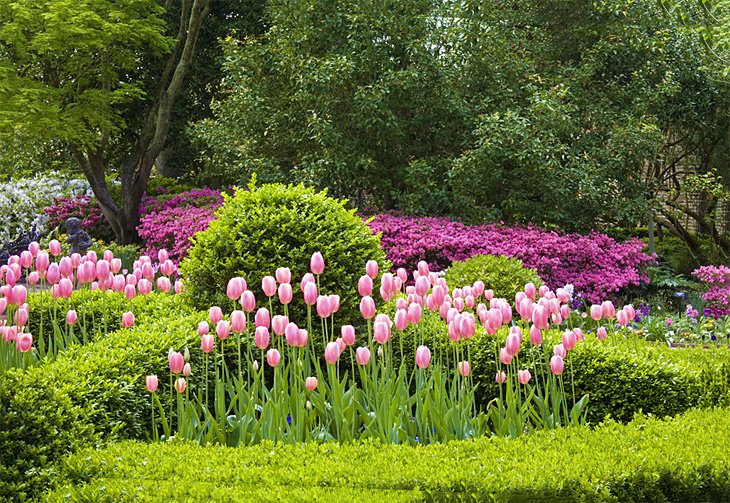
After walking past so many aristocratic mansions with their verandahs and imposing facades, you'll certainly be curious to look inside. A number are open as house museums, some furnished and decorated as they were in their heyday, and all giving a glimpse of upper-crust life in old Charleston.
Two of these are maintained by the Historic Charleston Foundation. The 1808 Nathaniel Russell House, at 51 Meeting Street, is among America's most important Neoclassical homes, known for its free-standing, three-story staircase and its ornate plasterwork. It is furnished with part of the organization's valuable collection of fine and decorative art, and is also especially known for its beautiful gardens.
Another notable Foundation property is the Aiken-Rhett House, at 48 Elizabeth Street. The 1820 home is unique in having remained in the same family for 142 years until it became a museum.
Official site: https://www.historiccharleston.org
Cathedral of St. John the Baptist and Historic Churches
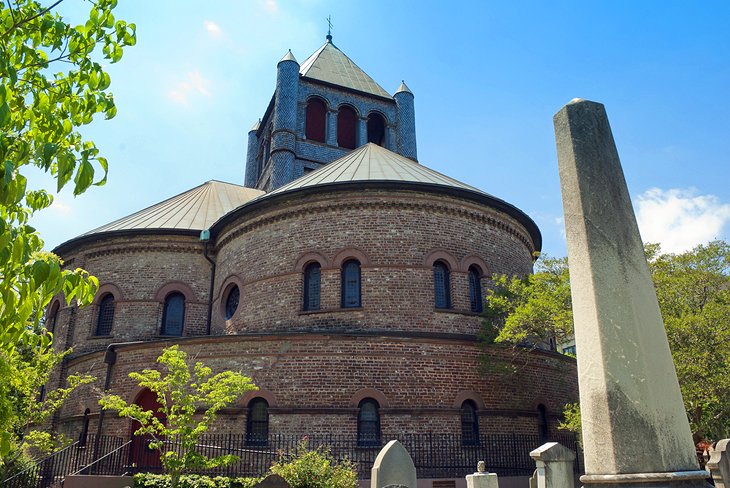
Remarkable historic churches are scattered throughout Charleston, and each has a story to tell. Among the city's most interesting is the brownstone Cathedral of St. John the Baptist, a neo-Gothic structure built to replace the previous cathedral, which was lost in the devastating 1861 fire that destroyed much of the city. The pews are carved from Flemish oak, and the three original altars are made of white marble. It has some notable stained glass windows as well.
Among Charleston's other interesting churches are the Romanesque-style Circular Congregational Church, with colonial burial grounds dating from 1695, and the French Huguenot Church, home to the oldest continuously active Huguenot congregation in the United States.
St. Michael's Episcopal Church, a National Historic Landmark, dates to 1751 and is known for its four stained glass windows by Tiffany Company of New York and for the cedar pew where George Washington sat in 1791.
Address: 120 Broad Street, Charleston, South Carolina
Official site: https://charlestoncathedral.com
Calhoun Mansion
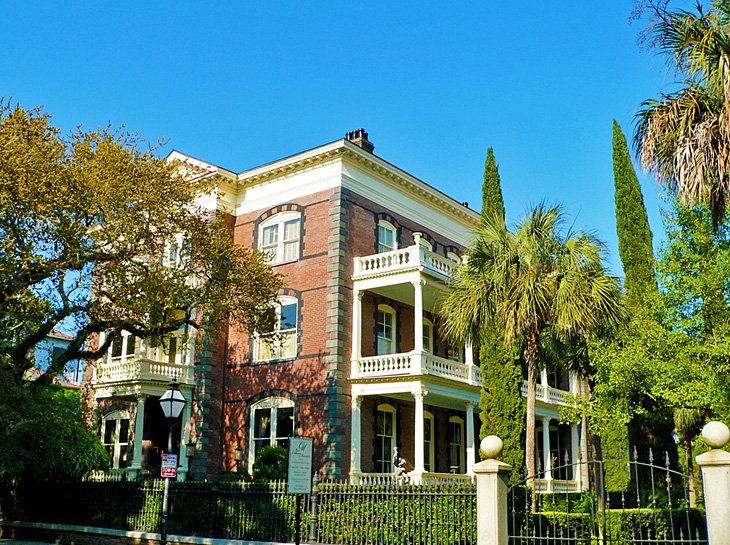
Representing a different era from the Historic Charleston Foundation's antebellum homes, the 1876 Italianate Calhoun Mansion is a prime example of Gilded Age décor and taste. Some of its 30 main rooms have Tiffany decorations, and they are filled (some might say overfilled, but that was the taste of the times) with outstanding collections of decorative arts of the late 19th-century era.
The ballroom has a 45-foot-high ceiling, and behind the mansion, you can stroll through the formal English gardens.
Address: 16 Meeting Street, Charleston, South Carolina
Official site: www.calhounmansion.net/
Tour Historic Homes at the Festival of Houses and Gardens
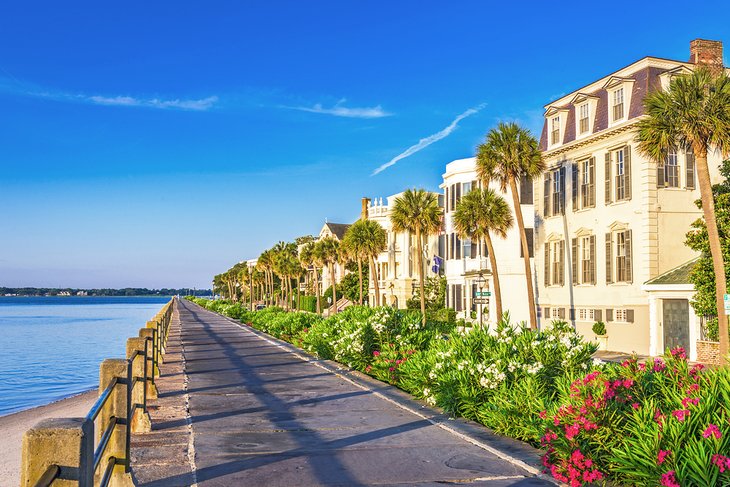
Organized by the Historic Charleston Foundation, the Annual Festival of Houses and Gardens features tours and educational programs specifically geared toward architectural and gardening enthusiasts.
Held during the peak of the blooming season, the Festival offers guests the rare chance to see inside the city's private homes and gardens. Approximately 150 of America's most distinctive historic houses, spread throughout 12 colonial and antebellum neighborhoods, are open to tour.
Official site: www.historiccharleston.org/Events/Annual-Festival-of-Houses-and-Gardens.aspx
Map of Attractions & Things to Do in Charleston, SC
Charleston - Climate Chart
| Average minimum and maximum temperatures for Charleston, SC in °C | |||||||||||
| J | F | M | A | M | J | J | A | S | O | N | D |
| 14 6 | 16 7 | 19 11 | 23 15 | 27 19 | 29 23 | 32 25 | 31 24 | 28 22 | 24 17 | 20 12 | 16 7 |
| PlanetWare.com | |||||||||||
| Average monthly precipitation totals for Charleston, SC in mm. | |||||||||||
| 92 | 67 | 97 | 62 | 70 | 126 | 140 | 166 | 156 | 77 | 55 | 71 |
| Average minimum and maximum temperatures for Charleston, SC in °F | |||||||||||
| J | F | M | A | M | J | J | A | S | O | N | D |
| 57 42 | 60 45 | 66 52 | 73 59 | 80 67 | 85 74 | 89 77 | 87 76 | 83 72 | 75 62 | 68 53 | 60 45 |
| PlanetWare.com | |||||||||||
| Average monthly precipitation totals for Charleston, SC in inches. | |||||||||||
| 3.6 | 2.6 | 3.8 | 2.4 | 2.8 | 5.0 | 5.5 | 6.5 | 6.1 | 3.0 | 2.2 | 2.8 |
